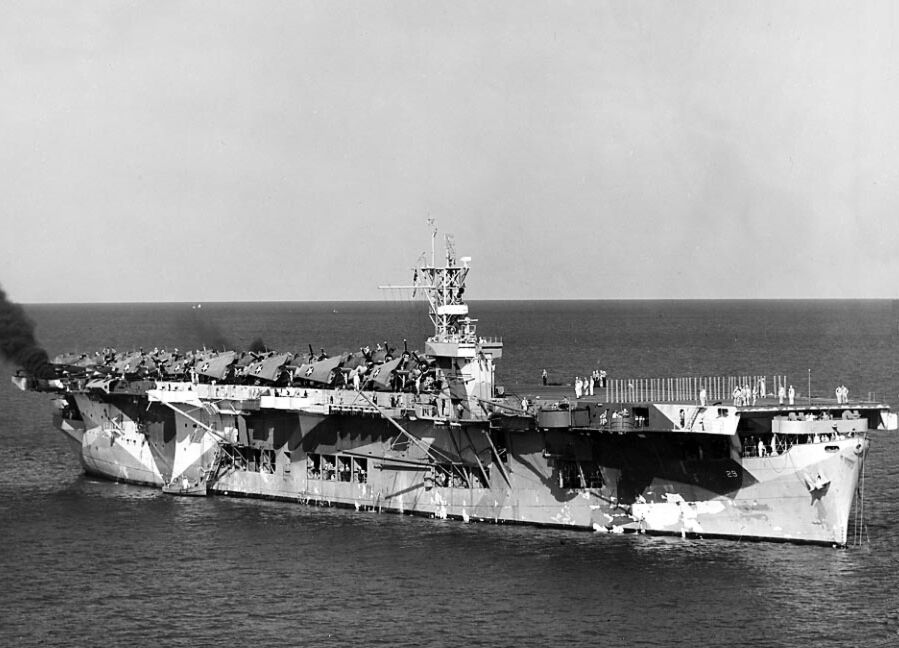The following article on the escort carrier program is an excerpt from Barrett Tillman’s book On Wave and Wing: The 100 Year Quest to Perfect the Aircraft Carrier. It is available to order now at Amazon and Barnes & Noble.
Among the miracles of production in the Second World War was America’s escort carrier program. For scale and efficiency, few industrial achievements could match it.
When the United States abruptly faced a severe shortage of flight decks in December 1941, a quick fix was found. Merchant ship hulls could be converted to “baby” or “jeep” carriers capable of operating as many as thirty aircraft. The British had pioneered the concept, but could not meet the numbers required—hence the Royal Navy’s reliance on its “rich uncle in America.”
USS Long Island was the first American escort carrier, originally designated ACV-1 (auxiliary aircraft carrier). Commissioned in June 1941, she was capable of 17 knots and proved the merchant conversion concept, but saw little combat.
The next four escort carriers were the Sangamon class, converted from oilers to flattops in as little as six months. They were 11,600-ton ships with two elevators to operate twenty-five planes.
Next came the Bogue class, ten escort carriers serving in the U.S. Navy and thirty-four with Britain as the Attacker and Ruler classes. They were small, usually less than five hundred feet in length, but weighed as much as 14,400 tons and proved highly versatile. Most entered service between early 1942 and early 1944.
Finally, the immensely successful Casablanca class produced fifty escort carriers in twenty-one months. More remarkably, they were commissioned in the year between July 1943 and July 1944. It was a stunning accomplishment, as Henry Kaiser’s Vancouver, Washington, shipyard built not only escort carriers, but turned out Liberty transport and cargo ships in as little as ninety days.
Small and lightly armored, “baby flattops” lent themselves to grim sailors’ humor. Some insisted that CVE stood for “combustible, vulnerable, and expendable.” Others said they were “two-torpedo ships” because the second torpedo would pass over the flight deck.
Seeandbee, acquired in March 1942, was commissioned in August as USS Wolverine (IX-64). The IX designator indicated a miscellaneous vessel. Her partner emerged as Sable (IX-81) in May 1943, both displacing about seven thousand tons as carriers. Because they were based at Chicago’s Navy Pier, their lack of a hangar deck was of little concern.
Wolverine’s flight deck measured five hundred feet in length, while Sable’s was 535, both about ninety-eight feet wide. Thus, their decks were shorter than a Casablanca-class CVE (476 x 80) but somewhat wider.
Wolverine began qualifying carrier pilots in September 1942, and by war’s end she and Sable were credited with producing 17,820 aviators who logged nearly 120,000 landings. (Originally pilots needed eight landings to qualify, later reduced to six.) In those three years the ships also trained forty thousand flight deck crewmen—essential supporting players in the carrier aviation cast.
Pilots reported to NAS Glenview from around the country, regardless of their ultimate carrier assignment. Retired Captain Chuck Downey recalled his experience as an eighteen-year-old “nugget” aviator in 1943. “We were only there for about three days. We spent a couple days working with an LSO, practicing carrier approaches at a training field, and then when he felt we were ready, he sent us out to the carrier.”
However, unavoidable complications arose. Inevitably the smoke from coal-burning engines wafted ashore, depositing sooty residue over the urban area, including laundry hung out to dry. Beyond that, when operating within view of shore, the carriers caused major traffic jams as motorists slowed or stopped to take in the Navy air show.
Some 140 carrier aircraft sank in the Great Lakes, with eight known fatalities. A few planes survived well enough in fresh water to be retrieved and restored for museum display, a reminder.
This article on the escort carrier program is an excerpt from Barrett Tillman’s book On Wave and Wing: The 100 Year Quest to Perfect the Aircraft Carrier. It is available to order now at Amazon and Barnes & Noble.
You can also buy the book by clicking on the buttons to the left.
This article is part of our larger resource on the WW2 Navies warfare. Click here for our comprehensive article on the WW2 Navies.
Cite This Article
"Escort Carrier Program" History on the Net© 2000-2024, Salem Media.
April 21, 2024 <https://www.historyonthenet.com/escort-carrier-program>
More Citation Information.

